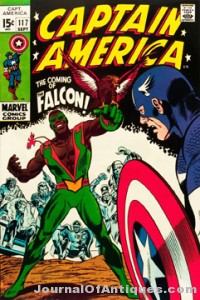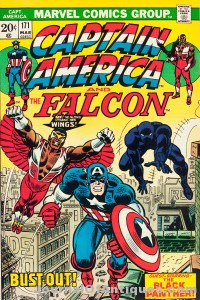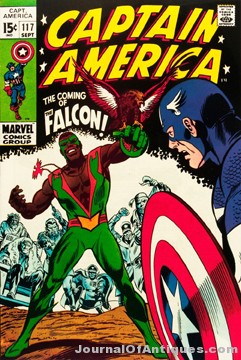Captain America Wins Again, and Again
By J.C. Vaughn
Captain America: The Winter Solider has scored another hit for Marvel Studios with a first weekend domestic take of $95,023,721 and international grosses of more than $207 million, according to BoxOfficeMojo.com. It’s always been a great time to collect the super soldier, the creation of Joe Simon and Jack Kirby, but now it’s a really good time…

Jack Kirby’s two-page re-telling of Captain America’s origin in Captain America #109 (cover dated January 1969) topped the Thursday, March 20, 2014 session of Hake’s Americana & Collectibles auction #211 with a final price of $43,320.50 (including the 15% buyer’s premium).
In a scene familiar to comic book fans and now moviegoers, the sequence shows Steve Rogers entering Dr. Erskine’s futuristic laboratory and being enhanced to the peak of human perfection by an experimental serum, in order to aid the United States government’s efforts to win World War II. The second page shows Rogers transforming from his previous scrawny physique to that of the muscular Captain America.
In this case, of course, Kirby was recreating his own work from 1941’s Captain America Comics #1.
The auction was Hake’s third in a row to top $1 million.
The Winter Solider
In Marvel’s Captain America: The Winter Soldier (and if you haven’t seen it, you might want to skip this section – this is your only spoiler warning ), Captain America’s main foe is the semi-bionic assassin known as The Winter Soldier, who is actually his seemingly long dead best friend, James Buchanan “Bucky” Barnes.
If you grew up reading comics in the 1960s or later, you more than likely know the first modern appearance of Captain America occurred in Avengers #4, which recounted how he survived the machinations of Baron Zemo while his teenage sidekick did not (a CGC-certified 9.6 copy of this issue just sold at Pedigree Comics for $17,250).
That wasn’t how the original comics had it — Captain America Comics was published by Timely, Marvel’s predecessor, from 1941 to 1950, and again for three issues in 1954 – when it was only low sales that killed off the characters. But continuity was not the strong suit of the Timely era or the Atlas period that followed the way it was when their incarnation as Marvel rolled around in the ‘60s.
Of course it’s not unusual for comic characters to come back from the dead with some incredible excuse of how they had actually survived (and of course comic books are hardly alone in this in entertainment). Along with Peter Parker’s Uncle Ben in Amazing Spider-Man, though, Bucky’s death was considered one of the few genuinely sacrosanct demises in comics.
In 2005, the eighth ongoing series featuring Cap began with Captain America #1. Writer Ed Brubaker and artist Steve Epting did the impossible and not only brought Bucky back, they did so in a way that won nearly universal acclaim from fans. The storyline served as the backbone for the feature film.
The Falcon
After Bucky Barnes, Sam Wilson, The Falcon was the first real partner Captain America had. First seen in Captain America #117, he was a street-savvy crime fighter on the neighborhood level. By issue #134 the cover proclaimed a new title: Captain America & The Falcon (it would run that way for just about 90 issues).
Along the way, readers discovered his true origins, changed costumes, got his famous wings (a gift from Black Panther #1970), discovered his mutant ability to communicate with his bird, Redwing, and found out just what made him tick. The character made his film debut in Captain America: The Winter Solider, although he’s been featured in animated programs from Marvel for a few years now.
In terms of publishing history, The Falcon is Marvel’s first African-American character to get his own series (Black Panther was, of course, from the mythical African country of Wakanda, not an American), and he was also the first not to have “Black” in the character name. He beat Luke Cage by three years for that distinction at Marvel and Green Lantern’s John Stewart by two years at DC.

Captain America wasn’t the only patriotic hero created by the legendary team of Joe Simon and Jack Kirby. In addition to the Guardian (blue outfit, carried a shield), the Silver Age Shield for Archie (who didn’t carry a shield), the duo also developed the Fighting American, one of the first heroes to delve into satire.
Will Eisner’s The Spirit had many satirical elements, as did Jack Cole’s work on Plastic Man which is much heralded today, but in the Fighting American Simon and Kirby turned a rye eye toward what the politics of the day when the series was launched in 1954.
Originally conceived as another riff on their established patriotic hero motif, the creators soured on the McCarthy-era definition of patriotism and ended up developing a character who parodied the climate and superheroes in general, but who still personified a more traditional patriotism including a love of free speech.
Radio announcer Johnny Flagg is murdered by foreign agents, but his younger, feeble brother, Nelson, allows his mind to be transferred to Johnny’s rebuilt and enhanced body as the Fighting American. Joined by the requisite sidekick, Speedboy, he confronted menaces such as Hotsky Trotsky, Poison Ivan, and Round Robin.
“It’s impossible to know for sure, but the reason it failed to find public acceptance may also be why it is so highly regarded today – it didn’t take itself or, apparently, the Cold War, seriously,” wrote Don Makstein on his Toonopedia website.
Fighting American ran seven issues from Prize, its original publisher. An eighth issue was completed, but didn’t appear until Harvey Comics released a one-shot in 1966 combined with the original #1.
The character returned when Marvel Comics collected all eight issues in a 1989 hardcover. A new incarnation debuted in a 1994 six-issue series from DC Comics, and Rob Liefeld brought the character back again under his Awesome Entertainment logo in 1997.
Another new version was announced more recently, but it did not happen. Titan Books has issued a new collection of the original Simon & Kirby material.
J.C. Vaughn is the Vice-President of Publishing for Gemstone Publishing.





Related posts: